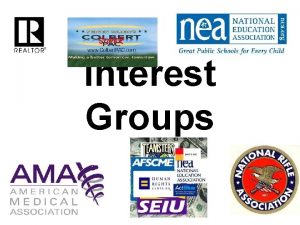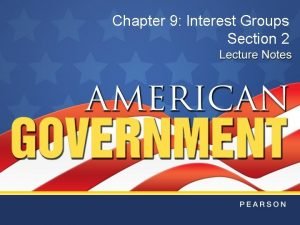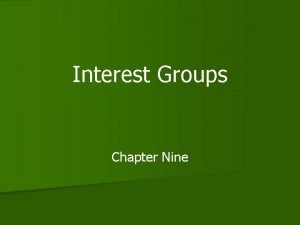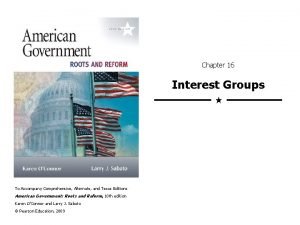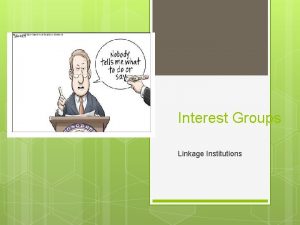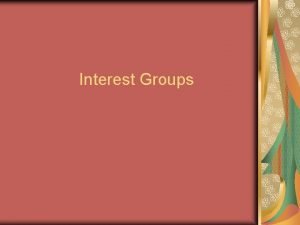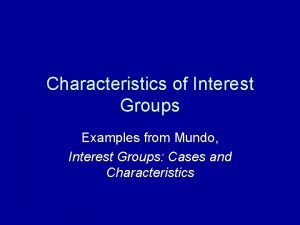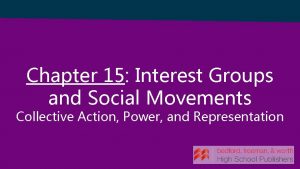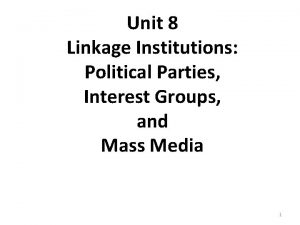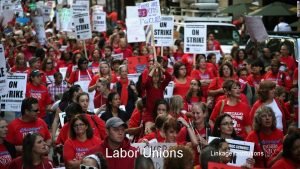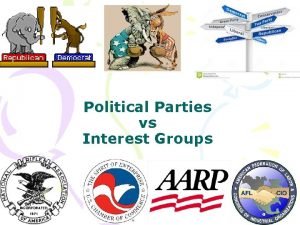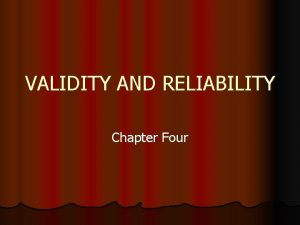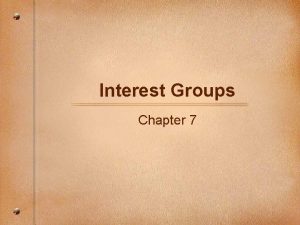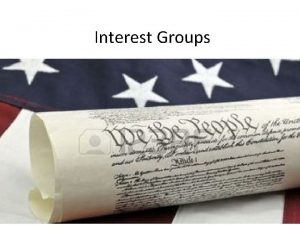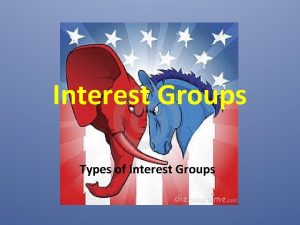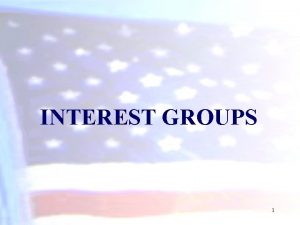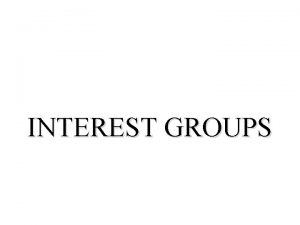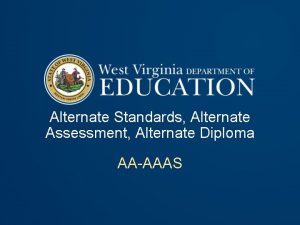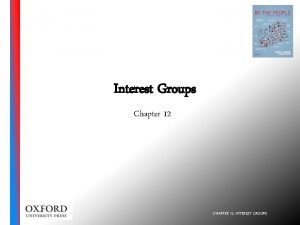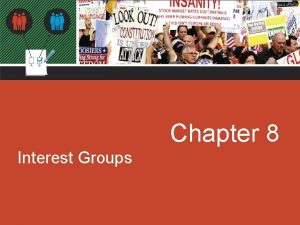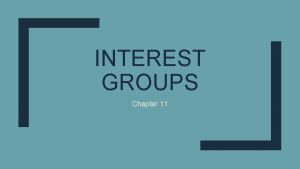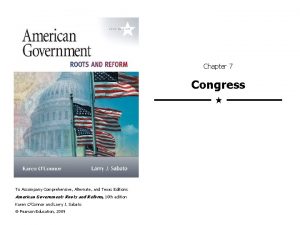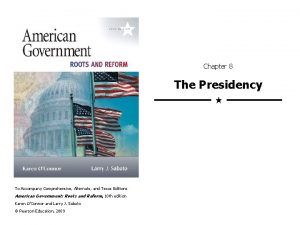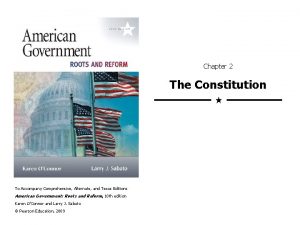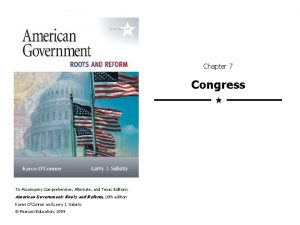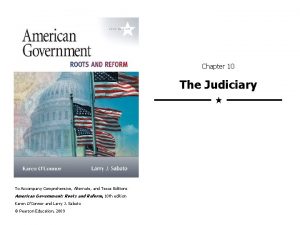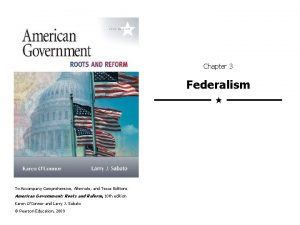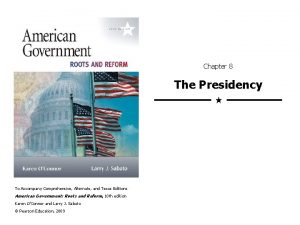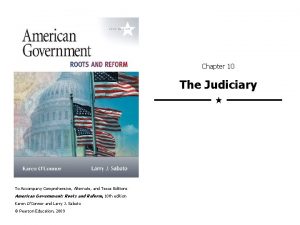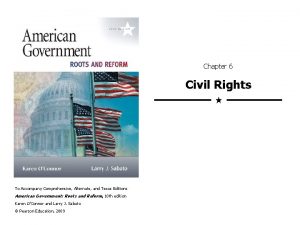Chapter 16 Interest Groups To Accompany Comprehensive Alternate























- Slides: 23

Chapter 16 Interest Groups To Accompany Comprehensive, Alternate, and Texas Editions American Government: Roots and Reform, 10 th edition Karen O’Connor and Larry J. Sabato Pearson Education, 2009

What are interest groups? How do they differ from political parties? • Organization that influences public policy • Web of cooperative relationships between citizens (social capital) that work towards a collective good (civic virtue) • Gives unrepresented or underrepresented an opportunity to be heard • Helps make government more representative of diverse populations • Greater access for powerful and wealthy

Pr es Special interest su re gr ou ps s ’ O G N Lobby Groups

Interest Group Theory Groups build social capital and civic virtue. Their main goal is to influence public policy. A variety of theories exist about why groups form. Pluralist theory, which is related to disturbance theory. Transactions theory. Neopluralist theory (i. e. population ecology theory).

Pluralist Theory • Political power is distributed among a wide array of competing interests • David B. Truman – ‘disturbance theory’ – New disturbances give way to new interest groups – Other interest groups form to counteract activities of these groups – Government role to provide forum for competing demands – Groups form when resources(clean air, equality, etc. ) are scarce

Transactions Theory – Mancur Olson The Logic of Collection Action • • Not rational for people to mobilize into groups People have perfect information Represent the elites Small groups that develop create more peer pressure (American civil rights movement) • Little incentive to join due to free rider problem – On issues of collective good

How are Interest Groups Formed Today? • • Internet No longer members of hierarchy organizations Much looser ties, but to more groups Move. On. Org and 527’s use text messaging to organize protests • Gather grassroots support online to join people with common interests • No longer fixed monthly/weekly meetings

Types of Organized Interests Public interest groups (i. e. NARAL, NRA). Economic interest groups (i. e. AFL-CIO, NAM). Governmental units, who lobby for earmarks. Political action committees (i. e. EMILY’s List). Multi-issue versus single-issue groups.

Kinds of Interests • Public Interest Groups – Seek collective good – Not motivated by self interest of members – Slavery, civil rights, environment, animals, mental ill • Economic Interest Groups – American Medical Association – AFL-CIO (labor organization) – Phillip Morris (now Altria) – Most fully and effectively organized

Kinds of Interests • Governmental Units – State and Local Governments – Intergovernmental Associations (International Associations • Conflict resolution, international relations, economic development (WTO, IMF, UN, OPEC) – Block grants and pork barrel projects • Non-Governmental Units (Not for Profits) – International – relieve suffering, promote the interests of the poor, protect the environment – Oxfam – deals with world hunger and poverty

Political Action Committees • 1974 amendments to the FECA • Investment arm, federally regulated, officially registered fund-raising committee • For Corporations, labor unions, interest groups • Raise funds from employees or members

Citizens United v Federal Election Commission • Mc. Cain–Feingold Act provision struck down by Supreme Court • prohibited all corporations, both for-profit and not-for-profit, and unions from broadcasting “electioneering communications. ” • Still cannot give directly to campaigns • Allowed for the documentary Hillary: The Movie to be viewed

Roots of Interest Groups First national groups emerge in 1830 s. Business interests play larger role after Civil War. Groups begin to send lobbyists to Washington Progressive era leads to an explosion of groups. Growth of labor and trade associations.

The Interest Group State Expansion of civil rights and groups in 1960 s. Development of conservative and religious groups. Evolution of new business groups dedicated to lobbying. Declining power of organized labor.

Lobbying Target Congress through research, money, or testimony. Also target bureaucratic agencies and the president. Lobby courts through sponsorship or amicus briefs. Can use grassroots techniques, such as petitions. May also resort to protests and activism.

Election Activities Recruiting and endorsing candidates. Organizing get out the vote efforts. Rating candidates and office holders. Establishing political action committees.

What Makes a Group Successful? Leaders, to inspire membership. Patrons, for funding. Members, who are involved at varying levels. Membership helps to overcome the free rider problem. Particularly true for groups that provide collective goods.

Regulating Interest Groups 1995 Lobbying Disclosure Act regulates Congress. Requires lobbyists to register and report payments. New 2007 Honest Leadership and Open Government Act. Bans gifts, toughens disclosure, increases time limits. Executive regulated by 1978 Ethics in Government Act.

AV- Interest Group Ratings Back

Table 16. 1 - Interest Group Profiles Back

Table 16. 2 - Lobbying Techniques Back

Table 16. 3 - Interest Group Membership Back

Table 16. 4 - Ethics in Government Act Back
 Accompany chapter 1
Accompany chapter 1 Things that belong to salvation
Things that belong to salvation Upper limb venous anatomy
Upper limb venous anatomy Printers create objects such as prototypes and models.
Printers create objects such as prototypes and models. Chapter 9 section 1 the nature of interest groups
Chapter 9 section 1 the nature of interest groups Chapter 9 section 2 types of interest groups
Chapter 9 section 2 types of interest groups How are ethnic groups and religious groups related
How are ethnic groups and religious groups related Free rider interest group
Free rider interest group The nature of interest groups
The nature of interest groups A virtue of interest groups is that
A virtue of interest groups is that Linkage institutions examples
Linkage institutions examples Proliferation of interest groups
Proliferation of interest groups State two characteristics of interest groups
State two characteristics of interest groups Interest groups vs social movements
Interest groups vs social movements Linkage institutions
Linkage institutions Interest groups
Interest groups Federalist 10 interest groups
Federalist 10 interest groups What are interest groups
What are interest groups Fundamental goal of interest groups
Fundamental goal of interest groups What is real interest rate and nominal interest rate
What is real interest rate and nominal interest rate Effective annual rate
Effective annual rate Simple interest and compound interest
Simple interest and compound interest Chapter 3 comprehensive exam
Chapter 3 comprehensive exam Alternate form of reliability
Alternate form of reliability




